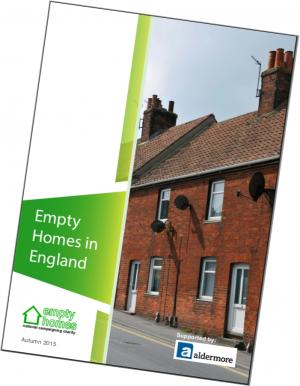



The Empty Homes Agency has produced a report about the numbers of empty homes in England, making recommendations for some key measures to bring the numbers down. The Agency has for many years been the custodian of figures about empty homes in England: but this beautifully-written report by Helen Williams is the first attempt for a more user-friendly approach to the statistics, featuring useful maps and clearly-written explanations of both methodology and interpretation.
For the first time, too, the EHA has commissioned some additional research by (Cobweb Consulting) which shows how the percentages of homes empty– both long- and short-term - correlate with house prices and deprivation. The results here are valuable but not surprising: the worse the deprivation and the lower the house prices, the more the number of empties.
In keeping with its user-friendly approach, the report features maps of the numbers of empty homes by local authority area, illustrating both absolute numbers and percentages of dwelling stock.
Practitioners will be most interested in the measures the EHA has chosen to recommend in order to address the problem of empty homes which we reproduce in full:
- Local authorities (as many do already) should have an empty homes strategy for their area, with aspirations to reduce the number of long-term empty homes and to attract and allocate resources to refurbish empty properties for those in housing need. Local authorities should work in partnership with property owners, housing associations and community organisations to realise their plan.
- Local authorities should (as many do already) take a case work approach with owners of empty properties to encourage, advise and support them to bring their homes back into use. Dedicated empty homes staff are a good way of ensuring that the council can act on information about empty homes and build up expertise in working with the owners, including in taking enforcement action where necessary.
- Central Government should re-establish dedicated grant funding programmes to support local authorities, housing associations and community organisations to bring empty homes back into use as affordable housing across England. By investing about £450 million, an additional 20,000 affordable homes could be created from long-term empty properties by 2020.
- Central Government should re-establish dedicated support for local authorities in areas with high concentrations of empty properties and this should extend neighbourhood regeneration approaches which reduce the number of long-term empty properties and bring wider area improvements.
- Local authorities with high concentrations of empty properties should explore how best to attract people back into these neighbourhoods, including by transferring streets of abandoned properties to community organisations to refurbish and rent them out to people in housing need; or selling homes below their market value to provide opportunities for people who would not otherwise be able to afford to buy the housing they need in the local housing market.
- The Mayor of London and local authorities in high value areas, should conduct studies to understand the extent and impact of buy-to-leave and review what measures they could adopt to incentivise people to bring those properties to the market for sale or rent; and to deter people in the first place, from buying properties primarily for their capital appreciation, rather than as a home to live in or rent out. Central Government should look at the case for supporting additional measures to deter buy-to-leave that may require legislation at a national level.
